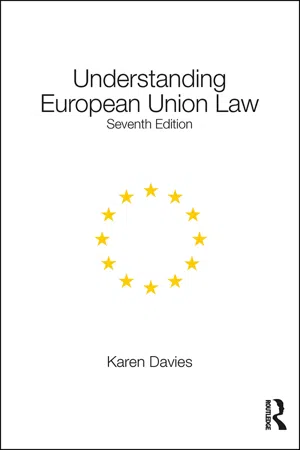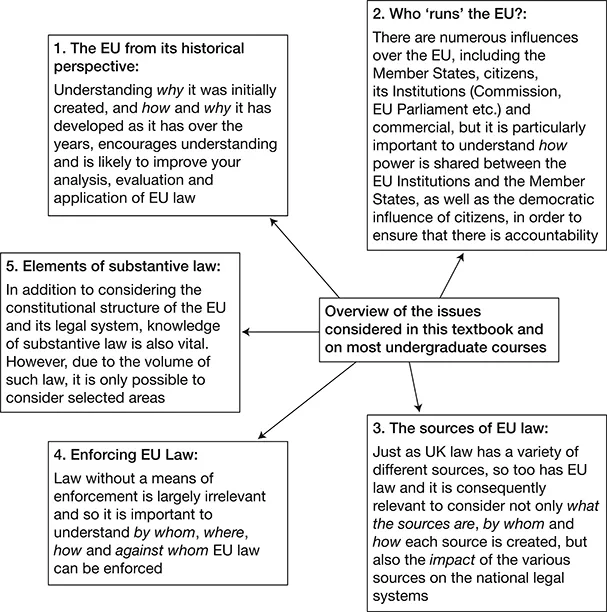![]()
1 Introduction
I. THE SIGNIFICANCE OF EU LAW
The United Kingdom’s (UK) membership of the European Union (EU) in 1973 resulted in EU law becoming an integral source of UK national law. Knowledge and understanding of the law of the EU is therefore indispensable to UK lawyers in the same way as knowledge of statute or common law is indispensable. (This is, of course, the same for lawyers not only in States which are members of the EU but also further afield, as national economies, societies and cultures have become integrated through a global network of trade, communication, immigration and transportation.)
However, even at this initial stage, it is important to acknowledge the fact that the UK has voted to withdraw its membership from the EU (known as ‘Brexit’) and that the significance of EU law in the UK is likely to undergo considerable change. At the time of writing, it is unclear what Brexit will mean for the UK and its future relationship with the EU and it is consequently important that lawyers (and that includes you, students of law!) remain alert to negotiations and agreements between the UK Government and the EU. (More discussion on Brexit and the process of withdrawal under Article 50 of the Treaty on European Union [TEU] is provided in Chapter 2.)
II. THE AIMS OF THIS BOOK
In recognition of the significance of EU law, it is vital that law students have a solid grounding in its principles. Many students, however, appear to find the study of EU law rather alarming, which is perhaps understandable given the differences of approach and terminology that often exist between the EU legal system and that of the UK (and other EU Member States). Students should, however, take heart; EU law goes back only a little more than 60 years and has, in the main, been developed with a specific set of aims in mind, which means that study can be quite manageable if approached in a logical, incremental manner.
In recognition of the breadth of EU law, most undergraduate EU law courses are limited to the principal constitutional and institutional areas of the EU legal order, together with selected areas of substantive law. Despite this approach, there are still quite significant areas of law to cover, and although there are a number of excellent textbooks providing detailed accounts of the law, such texts can be intimidating or overpowering and, consequently, rather daunting to the new student.
While this book aims to provide an account of the same constitutional and institutional principles together with important areas of substantive law, albeit in a less circuitous manner than many texts, a different approach has been attempted. At the beginning of each topic, before the legal principles are examined, each area of law is put into context, thus allowing an understanding of relevant issues to be developed.
In addition, at the end of most sections, knowledge and understanding are consolidated by the provision of diagrams or flowcharts, highlighting the main points at issue, together with tips and ‘thinking points’ to encourage you to further develop your understanding. Finally, a chapter on assessment provides advice on approaching coursework, revision and examinations.
Overall, this approach is intended to promote understanding of EU law as a whole, allowing students to develop a ‘feel’ for the subject and, hopefully, resulting in far less rote learning being necessary just before examinations!
III. YOUR APPROACH TO STUDYING EU LAW
Your attitude and approach to studying EU law can make all the difference to your enjoyment of the course and also to the end result. The subject of the UK’s membership of the EU has always been one of keen debate in the media and this may have coloured your feelings, making it difficult to arrive at the study of EU law with an open mind. However, this is an essential prerequisite to successful study.
During your course, you will be expected to attend lectures and tutorials or seminars. Do not underestimate the importance of these as learning tools. We all learn in various ways, not only through what we read, but also by listening, seeing and doing. Reading a variety of texts, legal journals and so on is essential to success but attending lectures can focus the mind, provide an introduction to a topic, shed light on areas of confusion and afford an alternative point of view.
Similarly, seminar attendance has numerous advantages (and of course attendance is normally compulsory). Attendance allows various topics or points to be focused upon; provides opportunity for discussion; allows for clarification; and is also likely to provide invaluable practice in answering coursework and exam-type questions. Be sure not to miss out on these valuable opportunities and don’t delude yourself into thinking that you can ‘get away with it’ by not spending adequate time preparing for classes, as the loss will be yours alone.
IV. FINDING RESOURCES ON EU LAW
There is a wealth of sources of information on EU law. Those enrolled on a structured course will normally be provided with at least an outline list of appropriate reading.
Make sure you have an up-to-date copy of relevant EU legislation at the start of your course. (This can be found in an EU statute book or accessed online.) If used regularly, you will find it invaluable. The Treaty on the Functioning of the European Union (TFEU), Treaty on European Union (TEU) and secondary legislation are, in the main, very readable and you should always read the various Treaty Articles and secondary legislation as you study them. The value of reading primary source materials is often underestimated by students who are new to law but, as you wouldn’t expect to complete a module on art appreciation without looking at a painting, why would you think that you can complete a law module without reading both legislation and case law?
In addition to more traditional sources of legal information, the internet has opened up a huge wealth of materials. The number of websites containing information on Union law appears to grow daily and it is a virtually impossible task to provide a comprehensive list. Do, however, take care only to consult those sites which are recognised legal databases (speak to your law librarian about these). The EU also has its own website (http://europa.eu) and, while learning to navigate the resource may take a little time, the benefits can be enormous: TRY IT!
Furthermore, the EU Institutions produce a wealth of information on various aspects of the European Union, most of which is free to access. A list of such publications, together with details of how to order, can be found on the Europa website.
V. BEGINNING YOUR STUDIES
1. Coping with terminology
Law students often remark that, when they begin their study of a particular branch of law, not only do they have to get to grips with new legal principles, legislation, case law and so on, but they also have to cope with legal jargon that is particular to that area of law. This is certainly true of EU law and students new to the area may find themselves confused by its terminology or ‘jargon’.
It is, however, important to recognise that lawyers (and other specialists) regularly use jargon as a form of shorthand when communicating with one another and so it is vital to become familiar with relevant terminology, as failing to do so can have serious consequences and students who fail to recognise this may never fully understand the law beyond the jargon.
In order to overcome this problem, this book provides a glossary of commonly used EU terminology. Make life easier for yourself by consulting this at the beginning of your studies and also refer to it throughout. The Europa website also has a glossary, accessible at https://eur-lex.europa.eu/summary/glossary.html.
2. EEC, EC or EU?
One important issue of terminology that needs to be addressed at the outset are the different names which have been afforded to ‘Europe’ over the years. Once quite commonly referred to as the ‘common market’, the formal names by which the EU has been known over the years are the European Economic Community (EEC), European Community (EC) and the European Union (EU).
The EEC was created by the Treaty of Rome in 1957. This Community was subject to a change of name in 1993, following the enactment of the Treaty on European Union 1992 (TEU, also commonly referred to as the Maastricht Treaty, after the city in which it was signed), when it became the EC. Confusingly, the TEU also created the EU. Further confusion arises because the EU was, at that time, a complex structure made up of a number of parts, one of which was the EC. The EC was part of the EU, but not the same as it! However, since the entry into force of the Treaty of Lisbon 2009, the EC no longer exists as an entity in its own right and has been superseded by the EU. Consequently, all contemporary references should now be to the EU and it is only when a historical perspective is being taken that the EEC or EC should be used. This should become clearer once Chapter 2 has been read and digested!
3. Dealing with case names
Students of EU law often find the names of the decisions of the Court of Justice of the European Union (known as the CJEU, the ECJ or simply the Court) to be a nightmare!
When it is considered that the EU comprises 28 different States, and has almost as many official languages, it is understandable that case names should occasionally prove difficult to pronounce and spell. Few lawyers would pretend that Case 109/88, Handels-OG Kontorfunktionaernesforbund v Dansk Arbeejdsgiverforening, flows easily off either the tongue or the pen. Despair can be avoided, however, once it is recognised that many EU law cases have ‘nicknames’ that are normally acceptable for use in examinations (but do check with your tutor). For example, the commonly used name for the above case is Danfoss which, I am sure you will agree, is quite manageable!
4. Make sure you know where you are going
Moving forward is far easier if you know in which direction you’re going and the same can be said of studying EU law. It is not sufficient to know that you are going to study EU law: in order to make studying as pain-free as possible, and even enjoyable (yes!), you need to have some knowledge of precisely what areas of EU law you are going to study and, importantly, why you are studying them.
If you are provided with a module guide or handbook, such information is normally contained within it. Generally, undergraduate EU law courses follow a scheme, which is roughly that of this book (the diagram on the next page illustrates this).
Overview of a typical EU Law undergraduate course
VI. CONCLUSIONS
Hopefully, this book will not be seen as just another simplified or insubstantial text but rather as an introduction to the law of the European Union, ensuring that all who access it gain a firm foundation on which to build broader and deeper knowledge. No strong, high or enduring wall was ever built without a sound foundation being put in place first!
Remember that this book does not profess to contain all you will need to know about the law of the European Union but, hopefully, it will provide you with the desire and tools to develop your knowledge. Finally, if there is something you do not understand, please ASK! Most tutors worth their salt will be only too happy to help.
![]()
2 The creation of a European Union
I. THE EUROPEAN COMMUNITIES: WHY THEY WERE CREATED AND WHAT DID THEY COMPRISE?
The best way to understand European Union (EU) law is to start at the beginning, which inevitably involves consideration of why the EU exists at all and it is possible to highlight...


